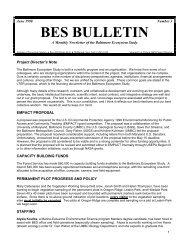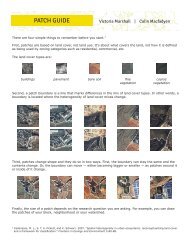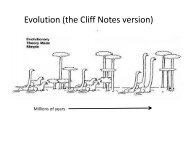Investigations in Urban Soils - Baltimore Ecosystem Study
Investigations in Urban Soils - Baltimore Ecosystem Study
Investigations in Urban Soils - Baltimore Ecosystem Study
Create successful ePaper yourself
Turn your PDF publications into a flip-book with our unique Google optimized e-Paper software.
Draft 2 - (9.28.04)<br />
<strong>Soils</strong> <strong>Urban</strong> <strong>in</strong> <strong>Investigations</strong><br />
d. Choose one BES graph. Thoroughly describe the data <strong>in</strong> that graph.<br />
Which habitat had the least worms? Most? How many study plots were<br />
sampled to calculate the average? When were the worms collected?<br />
e. List factors that the scientists measured that we did not measure.<br />
f. Choose one BES table or graph. Write at least three <strong>in</strong>terpretations you<br />
can draw from the results.<br />
g. Choose one BES table. Display the <strong>in</strong>formation <strong>in</strong> the table us<strong>in</strong>g an<br />
appropriate graph or chart.<br />
h. Why do you th<strong>in</strong>k the scientists measured worm biomass at Cub Hill <strong>in</strong><br />
the summer of 2002? (If the class did not measure biomass…) Would<br />
measur<strong>in</strong>g biomass enhance our data?<br />
i. Imag<strong>in</strong>e that BES agrees to put our data on the BES website. Write an<br />
explanation of how our data <strong>in</strong>creases scientific knowledge of earthworms<br />
<strong>in</strong> urban habitats.<br />
2. Make a class list of factors that the scientists measured, but that the class did not<br />
measure, such as biomass, or collect<strong>in</strong>g worms from a play<strong>in</strong>g field.<br />
3. Guide students to modify<strong>in</strong>g their <strong>in</strong>vestigation. Students may want to go back to<br />
the same study plots and collect additional data as well as another round of<br />
worms; or they may decide they need to collect the same <strong>in</strong>formation from new<br />
habitats.<br />
Days 10 - 11: Return to Investigation<br />
Students return to their sites and make the new measurements they decided on. The next day<br />
they process their results. The class discusses possible explanations for results.<br />
Materials:<br />
worm sampl<strong>in</strong>g equipment for each team (see Day 4)<br />
data table for record<strong>in</strong>g observations and measurements<br />
additional tools (thermometer, light or moisture meter, scale) as needed<br />
digital camera<br />
Preparation:<br />
1. Prepare new data table <strong>in</strong> advance, based on the class revisions to the<br />
observations and data they want collected.<br />
Procedure:<br />
1. Supervise students collect<strong>in</strong>g worms and observations/measurements.<br />
2. Guide students <strong>in</strong> process<strong>in</strong>g and display<strong>in</strong>g data.<br />
3. Help students select and discuss factors that had the largest impact on<br />
earthworm population, based on the experimental results. Mak<strong>in</strong>g careful<br />
<strong>in</strong>terpretations is very important to students’ understand<strong>in</strong>g the significance of<br />
results (see Interpretations from 2003 <strong>in</strong> section below).<br />
4. If time allows, email student conclusions to the scientist for feedback.<br />
page 34 <strong>Baltimore</strong> <strong>Ecosystem</strong> <strong>Study</strong><br />
– <strong>Investigations</strong> <strong>in</strong> <strong>Urban</strong> <strong>Soils</strong>






